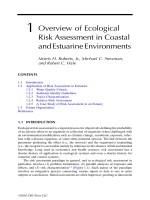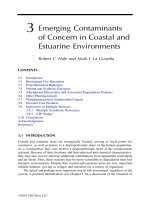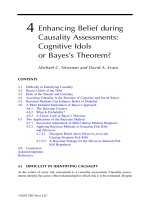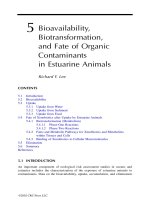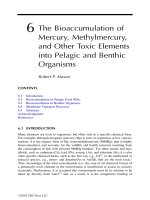Coastal and Estuarine Risk Assessment - Chapter 0 pps
Bạn đang xem bản rút gọn của tài liệu. Xem và tải ngay bản đầy đủ của tài liệu tại đây (486.93 KB, 11 trang )
©2002 CRC Press LLC
This book contains information obtained from authentic and highly regarded sources. Reprinted material
is quoted with permission, and sources are indicated. A wide variety of references are listed. Reasonable
efforts have been made to publish reliable data and information, but the authors and the publisher cannot
assume responsibility for the validity of all materials or for the consequences of their use.
Neither this book nor any part may be reproduced or transmitted in any form or by any means, electronic
or mechanical, including photocopying, microfilming, and recording, or by any information storage or
retrieval system, without prior permission in writing from the publisher.
All rights reserved. Authorization to photocopy items for internal or personal use, or the personal or
internal use of specific clients, may be granted by CRC Press LLC, provided that $1.50 per page
photocopied is paid directly to Copyright Clearance Center, 222 Rosewood Drive, Danvers, MA 01923
USA. The fee code for users of the Transactional Reporting Service is ISBN 1-56670-556-
8/02/$0.00+$1.50. The fee is subject to change without notice. For organizations that have been granted
a photocopy license by the CCC, a separate system of payment has been arranged.
The consent of CRC Press LLC does not extend to copying for general distribution, for promotion, for
creating new works, or for resale. Specific permission must be obtained in writing from CRC Press LLC
for such copying.
Direct all inquiries to CRC Press LLC, 2000 N.W. Corporate Blvd., Boca Raton, Florida 33431.
Trademark Notice:
Product or corporate names may be trademarks or registered trademarks, and are
used only for identification and explanation, without intent to infringe.
Visit the CRC Press Web site at www.crcpress.com
© 2002 by CRC Press LLC
Lewis Publishers is an imprint of CRC Press LLC
No claim to original U.S. Government works
International Standard Book Number 1-56670-556-8
Library of Congress Card Number 2001037702
Printed in the United States of America 1 2 3 4 5 6 7 8 9 0
Printed on acid-free paper
Library of Congress Cataloging-in-Publication Data
Coastal and estuarine risk assessment / editors, Michael C. Newman, Morris H. Roberts,
Jr., Robert C. Hale.
p. cm. — (Environmental and ecological risk assessment)
Includes bibliographical references (p. ).
ISBN 1-56670-556-8 (alk. paper)
1. Marine pollution—Environmental aspects. 2. Estuarine pollution—Environmental
aspects. 3. Ecological risk assessment. 4. Coastal animals—Effect of water pollution on.
5. Estuarine animals—Effect of water pollution on. I. Newman, Michael C. II. Roberts,
Morris H. III. Hale, Robert C. IV. Series.
QH545.W3 C59 2001
577.7
′
27—dc21 2001037702
©2002 CRC Press LLC
Preface
Experts working in diverse areas of coastal and estuarine risk assessment contributed
to this first volume of the CRC Press Environmental Risk Series. Contributors were
asked to address a comprehensive series of important topics including the regulatory
context for coastal and estuarine risk assessment, emerging contaminants of concern,
effects to marine mammals, bioavailability and exposure of marine organisms to
inorganic and organic contaminants, and effects of contaminants on ecological
entities ranging from biomolecules to landscapes.
Coastal and Estuarine Risk Assessment
is the first book to address the appli-
cation of the current risk assessment paradigm to coastal marine environments.
Chapter authors bring together experiences from academia, private consultancies,
and government agencies, resulting in a blending of diverse experiences, insights,
and vantages.
©2002 CRC Press LLC
The Editors
Michael C. Newman, Ph.D.,
is a Professor of Marine Science and the Dean of
Graduate Studies at the College of William and Mary’s Virginia Institute of Marine
Science/School of Marine Science (VIMS/SMS). After receiving B.A. and M.S.
(Zoology with marine emphasis) degrees from the University of Connecticut, he
earned M.S. and Ph.D. (1981) degrees in Environmental Sciences from Rutgers
University. He joined the faculty at the University of Georgia’s Savannah River
Ecology Laboratory (SREL) in 1983, becoming a SREL group head in 1996. He
left SREL to join the VIMS/SMS faculty in 1998, and became the Dean of Graduate
Studies for the School of Marine Science in 1999.
Dr. Newman’s research interests include quantitative methods for ecological risk
assessment and ecoepidemiology, population responses to toxicant exposure includ-
ing genetic responses, QSAR-like models for metals, bioaccumulation and toxico-
kinetic models for metals and radionuclides, toxicity models including time-to-death
models, and environmental statistics. He has published more than 85 articles on
these topics. He has co-edited three books:
Metal Ecotoxicology: Concepts and
Applications
(1991);
Ecotoxicology: A Hierarchical Treatment
(1996); and
Risk
Assessment: Logic and Measurement
(1998). He has written three additional books:
Quantitative Methods in Aquatic Ecotoxicology
(1995);
Fundamentals of Ecotoxi-
cology
(1998); and
Population Ecotoxicology
(2001).
Morris H. Roberts, Jr., Ph.D.,
is a Professor of Marine Science and Chair of the
Department of Environmental Sciences at the College of William and Mary’s
VIMS/SMS. Upon completing undergraduate work at Kenyon College, he earned
M.A. and Ph.D. (1969) degrees at the College of William and Mary in the School
of Marine Science. He joined the faculty of Providence College to teach invertebrate
zoology to upper-level students. In 1971, he became first Director of Invertebrate
Studies and later Director of Research at the former Aquatic Sciences, Inc. He
returned to VIMS/SMS as a faculty researcher in 1973, assuming his present role
as department chair in 1994.
Dr. Roberts’ current research focuses on the determination of ambient toxicity
in estuarine and tidal freshwater systems. This work includes laboratory tests of
ambient waters and sediments, and
in situ
tests of ambient waters. Earlier research
involved evaluating the acute toxicity of chlorine and bromine chloride, Kepone,
and TBT to estuarine species, bioaccumulation of PAH, Kepone and TBT in selected
species, and the effects of PAH-contaminated sediment on fish and invertebrate
species. He and his students have published over 60 articles and made over 35
presentations on these topics. He co-edited the book,
Water Chlorination Volume 6
(1985). Consistent with his interest in the methods of toxicology, he chaired the
Aquatic Toxicology Subcommittee of ASTM Committee E47 and was responsible
©2002 CRC Press LLC
for preparing a compilation of all methods developed by the Committee (first edition,
1993; second edition, 1999).
Robert C. Hale, Ph.D.,
is an Associate Professor of Marine Science at the College
of William and Mary’s VIMS/SMS. His interest in pollutants and aquatic environ-
ments led him to obtain a B.S. in Chemistry and B.A. in Biology from Wayne State
University, and then a Ph.D. in Marine Science from the College of William and
Mary in 1983. He then joined Mobil Corporation’s Environmental and Health Sci-
ences Laboratory in Princeton, NJ. His activities as an Environmental Research
Chemist at Mobil included pesticide fate and metabolism, complex mixture behavior,
and ecotoxicology. He joined the VIMS/SMS faculty in 1987, receiving tenure in
1993 in the Department of Environmental Science.
Dr. Hale’s current research interests focus on the bioavailability of organic
contaminants in aquatic environments, and their fate and effects. Dr. Hale has also
been active in the area of progressive analytical techniques (e.g., supercritical fluid
extraction) for the determination of trace contaminants, as well as emerging con-
taminants, such as brominated flame retardants and non-ionic detergents. His group
has published more than 30 articles and made more than 70 scientific presentations
on these topics while at VIMS/SMS.
©2002 CRC Press LLC
Acknowledgments
This books results from the Coastal and Estuarine Risk Assessment Forum
(CERAF) which was held at the College of William and Mary (Williamsburg,
Virginia, U.S.A.; July 20–21, 2000). Presentations and discussions from that meet-
ing were incorporated into the chapters of this volume. We are grateful to the
presenters and other participants of that forum for their engaging dialogue. The
following individuals also provided invaluable assistance in the form of anonymous
chapter reviews: A. Aguirre, Tufts University; S. Bartell, Cadmus Group; A. Bern-
hoft, National Veterinary Institute (Oslo); G.P. Cobb, Texas Tech University;
M. Crane, University of London, Royal Holloway; N. Denslow, University of Flor-
ida; R.T. Di Giulio, Duke University; W.S. Douglas, Symbiosis Environmental;
A.A. Elskus, University of Kentucky; N.S. Fisher, SUNY, Stony Brook; S. Ferson,
Applied Biomathematics; M.E. Hahn, Woods Hole Oceanographic Institution;
R.F. Lee, Skidaway Institute of Oceanography; M. Lydy, Wichita State University;
J.S. Meyer, University of Wyoming; G.L. Mills, University of Georgia, Savannah
River Ecology Laboratory; J.E. Perry, College of William and Mary–Virginia Insti-
tute of Marine Science; J.T. Phinney, American Society of Limnology and Ocean-
ography; P.S. Rainbow, The Natural History Museum (London); J. Reinfelder,
Rutgers University; C. Richards, University of Minnesota – Sea Grant College
Program; E.J. Scollon, Texas Tech University; C. Strojan, University of Georgia,
Savannah River Ecology Laboratory; M.A. Unger, College of William and
Mary–Virginia Institute of Marine Science; and P.A. Van Veld, College of William
and Mary–Virginia Institute of Marine Science.
©2002 CRC Press LLC
Contributors
Gary Bigham
Exponent, Inc.
15375 SE 30th Place
Bellevue, WA 98007
U.S.A.
Alan L. Blankenship
Entrix Inc.
and
Michigan State University
East Lansing, MI 48824
U.S.A.
Jenee A. Colton
Exponent, Inc.
15375 SE 30th Place
Bellevue, WA 98007
U.S.A.
Mark Crane
University of London
Royal Holloway
School of Biological Sciences
Egham, Surrey
TW20 0EX
U.K.
David A. Evans
Virginia Institute of Marine Science
College of William and Mary
Route 1208 Greate Road
Gloucester Point, VA 23062
U.S.A.
John P. Giesy
Michigan State University
Department of Zoology
Institute for Environmental Toxicology
National Food Safety
and Toxicology Center
East Lansing, MI 48824
U.S.A.
Timothy R. Gleason
U.S. Environmental Protection Agency
National Health Environmental Effects
Research Laboratory
Atlantic Ecology Division
27 Tarzwell Drive
Narragansett, RI 02882
U.S.A.
Albania Grosso
Environmental Resources Management
Wallbrook Court
North Hinksey Lane
Oxford
OX2 0QS
U.K.
Ruth Gutjahr-Gobell
U.S. Environmental Protection Agency
National Health Environmental Effects
Research Laboratory
Atlantic Ecology Division
27 Tarzwell Drive
Narragansett, RI 02882
U.S.A.
©2002 CRC Press LLC
Robert C. Hale
Virginia Institute of Marine Science
College of William and Mary
Route 1208 Greate Road
Gloucester Point, VA 23062
U.S.A.
Marina Huber
U.S. Environmental Protection Agency
National Health Environmental Effects
Research Laboratory
Atlantic Ecology Division
27 Tarzwell Drive
Narragansett, RI 02882
U.S.A.
Timothy J. Iannuzzi
BBL Sciences
326 First Street, Suite 200
Annapolis, MD 21403
U.S.A.
Paul D. Jones
Michigan State University
Department of Zoology
Institute for Environmental Toxicology
National Food Safety
and Toxicology Center
East Lansing, MI 48824
U.S.A.
Kurunthachalam Kannan
Michigan State University
Department of Zoology
Institute for Environmental Toxicology
National Food Safety
and Toxicology Center
East Lansing, MI 48824
U.S.A.
Mark J. La Guardia
Virginia Institute of Marine Science
College of William and Mary
Route 1208 Greate Road
Gloucester Point, VA 23062
U.S.A.
Byeong-Gweon Lee
Chonnam National University
Department of Oceanography
Kwang Ju
South Korea
Richard F. Lee
Skidaway Institute of Oceanography
10 Ocean Science Circle
Savannah, GA 31411
U.S.A.
Kenneth M. Y. Leung
Royal Holloway
University of London
School of Biological Sciences
Egham, Surrey
TW20 0EX
U.K.
Dave Ludwig
BBL Sciences
326 First Street, Suite 200
Annapolis, MD 21403
U.S.A.
Samuel N. Luoma
U.S. Geological Survey
Water Resources Division,
Mail Stop 465
345 Middlefield Road
Menlo Park, CA 94025
U.S.A.
Christopher E. Mackay
Exponent, Inc.
15375 SE 30th Place
Bellevue, WA 98007
U.S.A.
Robert P. Mason
University of Maryland
Center for Environmental Science
Chesapeake Biological Laboratory
P.O. Box 38
Solomons, MD 20688-0038
U.S.A.
©2002 CRC Press LLC
David Morritt
Royal Holloway
University of London
School of Biological Sciences
Egham, Surrey
TW20 0EX
U.K.
Wayne R. Munns, Jr.
U.S. Environmental Protection Agency
National Health Environmental Effects
Research Laboratory
Atlantic Ecology Division
27 Tarzwell Drive
Narragansett, RI 02882
U.S.A.
Diane E. Nacci
U.S. Environmental Protection Agency
National Health Environmental Effects
Research Laboratory
Atlantic Ecology Division
27 Tarzwell Drive
Narragansett, RI 02882
U.S.A.
Michael C. Newman
Virginia Institute of Marine Science
College of William and Mary
Route 1208 Greate Road
Gloucester Point, VA 23062
U.S.A.
Morris H. Roberts, Jr.
Virginia Institute of Marine Science
College of William and Mary
Route 1208 Greate Road
Gloucester Point, VA 23062
U.S.A.
Christian E. Schlekat
Environmental and Health Science
U.S. Borax
26877 Tourney Road
Valencia, CA 91355
U.S.A.
Neal Sorokin
Royal Holloway
University of London
School of Biological Sciences
Egham, Surrey
TW20 0EX
U.K.
James R. Wheeler
University of London
Royal Holloway
School of Biological Sciences
Egham, Surrey
TW20 0EX
U.K.
Paul Whitehouse
WRc-NSF
Henley Road
Medmenham, Marlow,
Buckinghamshire
SL7 2HD
U.K.
©2002 CRC Press LLC
Table of Contents
Chapter 1
Overview of Ecological Risk Assessment in Coastal
and Estuarine Environments
Morris H. Roberts, Jr., Michael C. Newman, and Robert C. Hale
Chapter 2
European Approaches to Coastal and Estuarine Risk Assessment
Mark Crane, Neal Sorokin, James R. Wheeler, Albania Grosso,
Paul Whitehouse, and David Morritt
Chapter 3
Emerging Contaminants of Concern in Coastal
and Estuarine Environments
Robert C. Hale and Mark J. La Guardia
Chapter 4
Enhancing Belief during Causality Assessments: Cognitive Idols
or Bayes’s Theorem?
Michael C. Newman and David A. Evans
Chapter 5
Bioavailability, Biotransformation, and Fate of Organic Contaminants
in Estuarine Animals
Richard F. Lee
Chapter 6
The Bioaccumulation of Mercury, Methylmercury, and Other Toxic
Elements into Pelagic and Benthic Organisms
Robert P. Mason
Chapter 7
Dietary Metals Exposure and Toxicity to Aquatic Organisms:
Implications for Ecological Risk Assessment
Christian E. Schlekat, Byeong-Gweon Lee, and Samuel N. Luoma
©2002 CRC Press LLC
Chapter 8
Endocrine Disruption in Fishes and Invertebrates: Issues for Saltwater
Ecological Risk Assessment
Kenneth M.Y. Leung, James R. Wheeler, David Morritt, and Mark Crane
Chapter 9
The Use of Toxicity Reference Values (TRVs) to Assess the Risks That
Persistent Organochlorines Pose to Marine Mammals
Paul D. Jones, Kurunthachalam Kannan, Alan L. Blankenship,
and John P. Giesy
Chapter 10
Effects of Chronic Stress on Wildlife Populations: A Population Modeling
Approach and Case Study
Diane E. Nacci, Timothy R. Gleason, Ruth Gutjahr-Gobell, Marina Huber,
and Wayne R. Munns, Jr.
Chapter 11
Structuring Population-Based Ecological Risk Assessments
in a Dynamic Landscape
Christopher E. Mackay, Jenee A. Colton, and Gary Bigham
Chapter 12
Incremental Chemical Risks and Damages in Urban Estuaries:
Spatial and Historical Ecosystem Analysis
Dave Ludwig and Timothy J. Iannuzzi
Chapter 13
Ecological Risk Assessment in Coastal and Estuarine Environments
Michael C. Newman, Robert C. Hale, and Morris H. Roberts, Jr.


